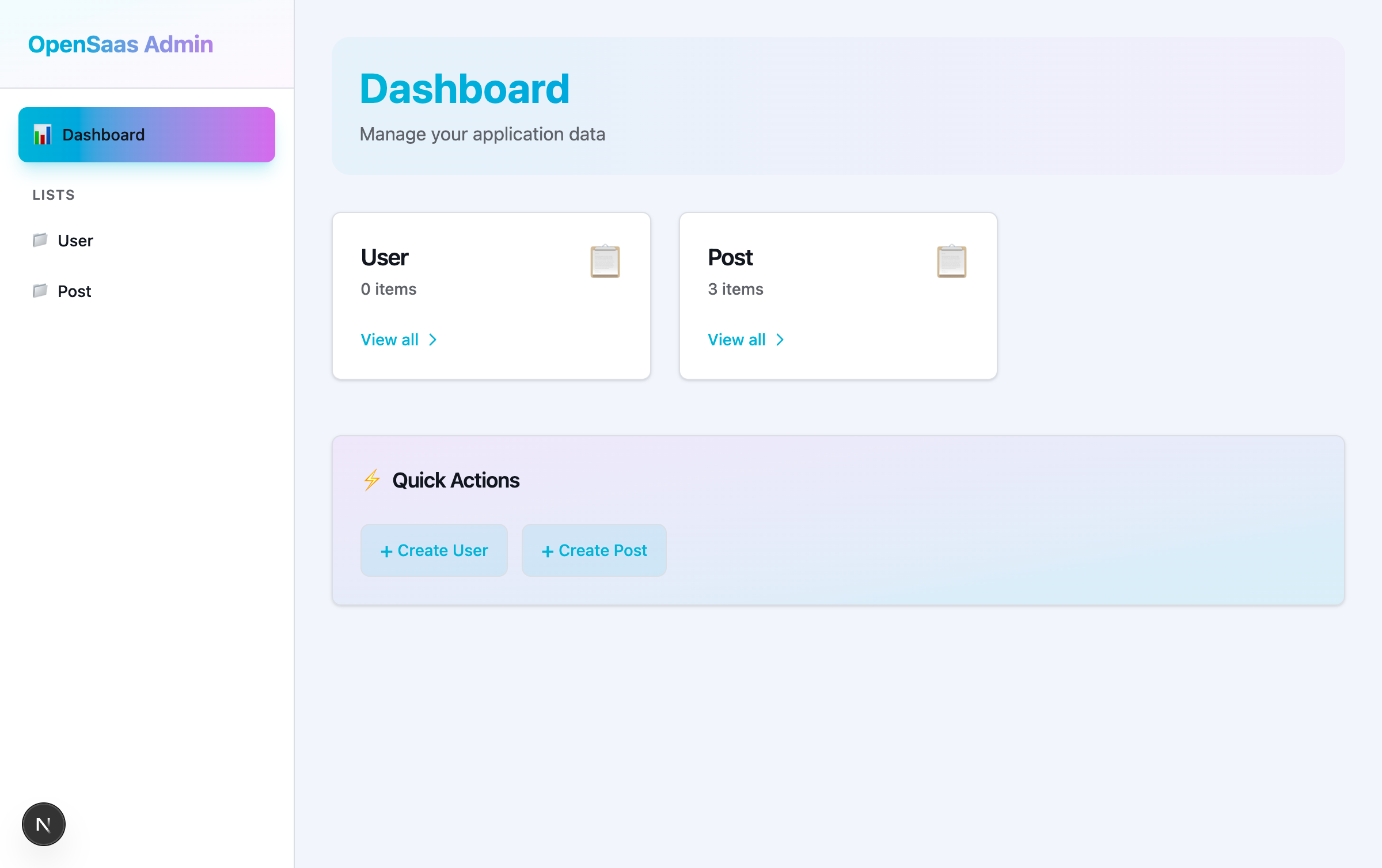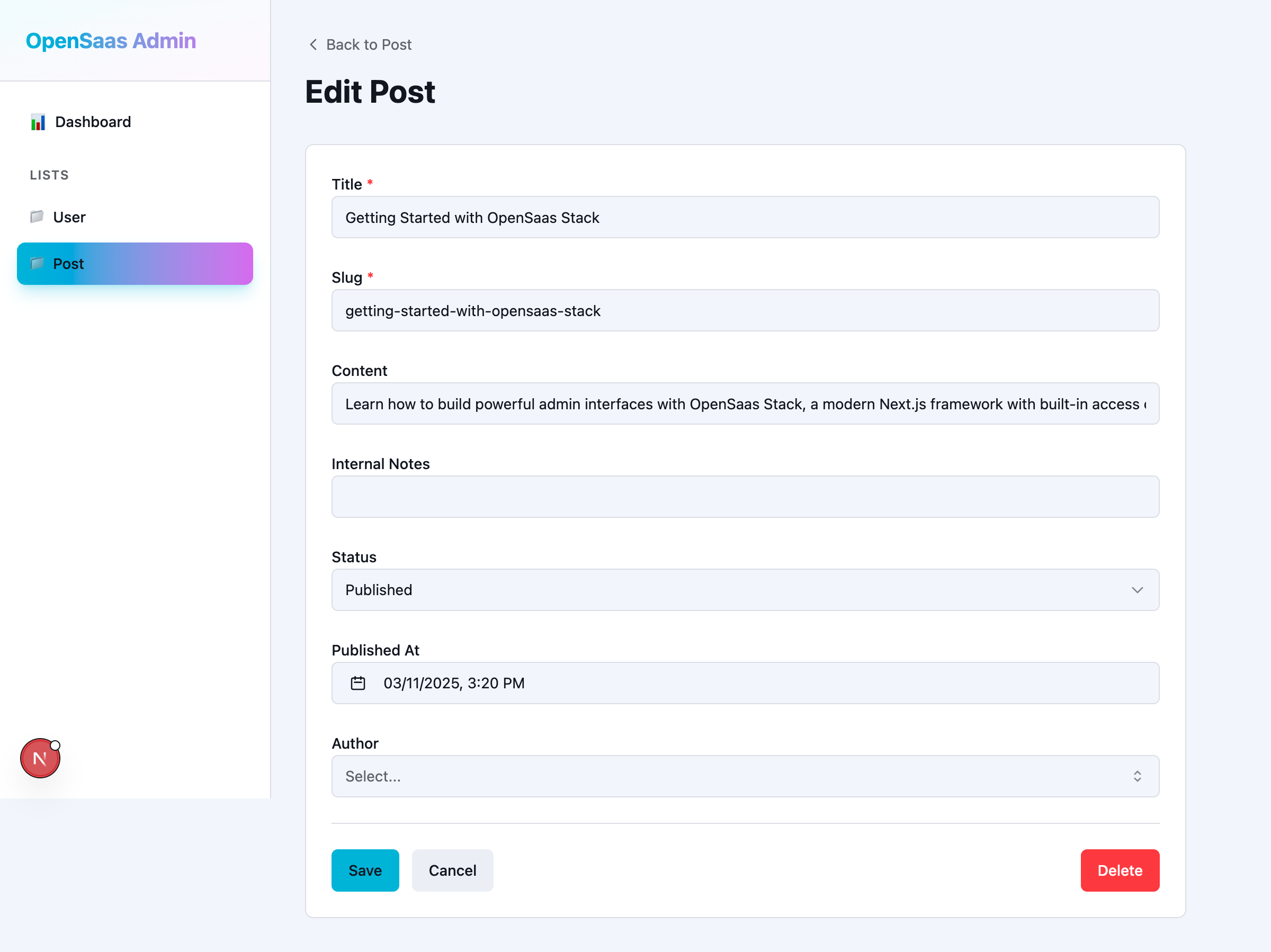@opensaas/stack-ui
Composable React UI components for building admin interfaces with OpenSaas Stack. Built on top of shadcn/ui primitives with full TypeScript support and multiple levels of abstraction.
Overview
The UI package provides everything you need to build admin interfaces, from complete out-of-the-box solutions to low-level primitives for custom UIs:
- AdminUI - Complete admin interface with routing, navigation, and CRUD operations
- Standalone Components - Drop-in components for forms, tables, and common UI patterns
- Field Components - Individual field inputs with validation and type safety
- Primitives - Low-level shadcn/ui components for building custom interfaces
Installation
pnpm add @opensaas/stack-ui
The UI package has peer dependencies on @opensaas/stack-core, next, react, and react-dom.
Quick Start
Full Admin Interface
The simplest way to add an admin interface to your Next.js app:
// app/admin/[[...admin]]/page.tsx
import { AdminUI } from '@opensaas/stack-ui'
import { getAdminContext } from '@opensaas/stack-ui/server'
import config from '@/opensaas.config'
import '@opensaas/stack-ui/styles'
export default async function AdminPage() {
const context = await getAdminContext()
return <AdminUI context={context} config={config} />
}
This gives you a complete admin interface with:
- Dashboard with list summaries and quick actions
- List views with search, sorting, and pagination
- Create and edit forms with validation
- Delete confirmation dialogs
- Responsive navigation sidebar

Package Exports
The UI package uses multiple export paths for different levels of abstraction:
// Main export - Full admin UI and utilities
import { AdminUI, registerFieldComponent } from '@opensaas/stack-ui'
// Primitives - shadcn/ui components
import { Button, Card, Input, Table } from '@opensaas/stack-ui/primitives'
// Field components - Individual field inputs
import { TextField, SelectField, RelationshipField } from '@opensaas/stack-ui/fields'
// Standalone components - Composable CRUD components
import { ItemCreateForm, ItemEditForm, ListTable } from '@opensaas/stack-ui/standalone'
// Server utilities - Context and session management
import { getAdminContext } from '@opensaas/stack-ui/server'
// Styles - Tailwind CSS
import '@opensaas/stack-ui/styles'
Core Components
AdminUI
The AdminUI component provides a complete admin interface with routing, navigation, and CRUD operations.
import { AdminUI } from '@opensaas/stack-ui'
import { getAdminContext } from '@opensaas/stack-ui/server'
import config from '@/opensaas.config'
export default async function AdminPage() {
const context = await getAdminContext()
return <AdminUI context={context} config={config} />
}
Props:
context- Admin context with session and database accessconfig- OpenSaas configuration object
Features:
- Automatic routing based on URL segments
- Navigation sidebar with list links
- Dashboard with list summaries
- List views with search and sorting
- Create and edit forms
- Delete confirmations
Dashboard
The dashboard shows an overview of your lists with item counts and quick actions.

Features:
- List summary cards with item counts
- "View all" links to list views
- Quick action buttons for creating items
- Responsive grid layout
ListView
The list view displays items in a table with search, sorting, and actions.

Features:
- Sortable columns
- Search functionality
- Edit and delete actions
- Pagination (coming soon)
- Responsive table layout
ItemForm
Forms for creating and editing items with validation and field-level access control.


Features:
- Automatic field rendering based on field type
- Client-side and server-side validation
- Field-level access control
- Required field indicators
- Error messages
- Cancel and delete actions
Standalone Components
Standalone components allow you to build custom admin interfaces by composing individual components.
ItemCreateForm
A standalone form for creating new items.
import { ItemCreateForm } from '@opensaas/stack-ui/standalone'
import { getAdminContext } from '@opensaas/stack-ui/server'
export default async function CreatePostPage() {
const context = await getAdminContext()
return (
<ItemCreateForm
listKey="Post"
context={context}
onSuccess={(item) => {
// Redirect or show success message
console.log('Created item:', item.id)
}}
onError={(error) => {
// Handle error
console.error('Failed to create:', error)
}}
/>
)
}
Props:
listKey- The name of the list (e.g., "Post", "User")context- Admin context with session and database accessonSuccess?- Optional callback when item is created successfullyonError?- Optional callback when creation fails
ItemEditForm
A standalone form for editing existing items.
import { ItemEditForm } from '@opensaas/stack-ui/standalone'
import { getAdminContext } from '@opensaas/stack-ui/server'
export default async function EditPostPage({ params }: { params: { id: string } }) {
const context = await getAdminContext()
return (
<ItemEditForm
listKey="Post"
itemId={params.id}
context={context}
onSuccess={(item) => {
console.log('Updated item:', item.id)
}}
onError={(error) => {
console.error('Failed to update:', error)
}}
/>
)
}
Props:
listKey- The name of the listitemId- The ID of the item to editcontext- Admin contextonSuccess?- Optional callback when item is updated successfullyonError?- Optional callback when update fails
ListTable
A standalone table component for displaying lists of items.
import { ListTable } from '@opensaas/stack-ui/standalone'
import { getAdminContext } from '@opensaas/stack-ui/server'
export default async function PostsPage() {
const context = await getAdminContext()
return (
<div>
<h1>Posts</h1>
<ListTable
listKey="Post"
context={context}
columns={['title', 'status', 'author', 'createdAt']}
/>
</div>
)
}
Props:
listKey- The name of the listcontext- Admin contextcolumns?- Optional array of field names to display (defaults to all fields)
SearchBar
A search input with button for filtering list views.
import { SearchBar } from '@opensaas/stack-ui/standalone'
export default function SearchPage() {
return (
<SearchBar
placeholder="Search posts..."
onSearch={(query) => {
console.log('Searching for:', query)
}}
/>
)
}
Props:
placeholder?- Placeholder text for the search inputonSearch- Callback function when search is submitted
DeleteButton
A button with confirmation dialog for deleting items.
import { DeleteButton } from '@opensaas/stack-ui/standalone'
export default function ItemActions({ itemId }: { itemId: string }) {
return (
<DeleteButton
listKey="Post"
itemId={itemId}
onSuccess={() => {
console.log('Item deleted')
}}
onError={(error) => {
console.error('Failed to delete:', error)
}}
/>
)
}
Props:
listKey- The name of the listitemId- The ID of the item to deleteonSuccess?- Optional callback when item is deleted successfullyonError?- Optional callback when deletion fails
Field Components
Field components are used internally by forms but can also be used directly for custom UIs.
Available Field Components
TextField- Text input for string fieldsIntegerField- Number input for integer fieldsCheckboxField- Checkbox for boolean fieldsSelectField- Dropdown for enum fieldsTimestampField- Date/time picker for timestamp fieldsPasswordField- Password input (hidden by default)RelationshipField- Combobox for relationship fields
Field Component Props
All field components share a common set of props:
interface FieldComponentProps {
name: string
value: any
onChange: (value: any) => void
label: string
error?: string
disabled?: boolean
required?: boolean
mode?: 'read' | 'edit'
// Additional props from field.ui options
}
Example Usage
import { TextField, SelectField } from '@opensaas/stack-ui/fields'
import { useState } from 'react'
export default function CustomForm() {
const [title, setTitle] = useState('')
const [status, setStatus] = useState('draft')
return (
<form>
<TextField
name="title"
value={title}
onChange={setTitle}
label="Title"
required
/>
<SelectField
name="status"
value={status}
onChange={setStatus}
label="Status"
options={[
{ label: 'Draft', value: 'draft' },
{ label: 'Published', value: 'published' },
]}
/>
</form>
)
}
Primitives
Low-level shadcn/ui components for building custom interfaces.
Available Primitives
Form Controls:
Input- Text inputTextarea- Multi-line text inputLabel- Form labelButton- Button componentCheckbox- Checkbox inputSelect- Dropdown select with full component set (SelectTrigger, SelectContent, SelectItem, etc.)Combobox- Searchable select with autocomplete
Layout:
Card,CardHeader,CardContent,CardFooter- Card componentsDialog,DialogContent,DialogHeader,DialogFooter- Modal dialogsPopover,PopoverTrigger,PopoverContent- Popover components
Data Display:
Table,TableHeader,TableBody,TableRow,TableCell- Table components
Date/Time:
Calendar- Calendar componentTimePicker- Time picker componentDateTimePicker- Combined date and time picker
Example Usage
import { Card, CardHeader, CardContent, Button, Input } from '@opensaas/stack-ui/primitives'
export default function CustomCard() {
return (
<Card>
<CardHeader>
<h2>Custom Form</h2>
</CardHeader>
<CardContent>
<Input placeholder="Enter text..." />
<Button>Submit</Button>
</CardContent>
</Card>
)
}
Customizing Field Components
The UI package uses a component registry pattern that allows you to customize how fields are rendered.
Global Registration
Register a component globally to use it across multiple fields:
// lib/register-fields.ts
'use client'
import { registerFieldComponent } from '@opensaas/stack-ui'
import { ColorPickerField } from './components/ColorPickerField'
registerFieldComponent('color', ColorPickerField)
Then use it in your config:
// opensaas.config.ts
import { config, list, text } from '@opensaas/stack-core'
export default config({
lists: {
Theme: list({
fields: {
primaryColor: text({ ui: { fieldType: 'color' } }),
secondaryColor: text({ ui: { fieldType: 'color' } }),
},
}),
},
})
Per-Field Override
Pass a component directly for one-off customization:
// opensaas.config.ts
import { SlugField } from './components/SlugField'
export default config({
lists: {
Post: list({
fields: {
slug: text({ ui: { component: SlugField } }),
},
}),
},
})
Component Resolution Priority
The FieldRenderer resolves components in the following order:
field.ui.component- Per-field override (highest priority)field.ui.fieldType- Global registry lookup by custom typefield.type- Default registry lookup by field type
Server Utilities
getAdminContext
Get an admin context with session from request headers.
import { getAdminContext } from '@opensaas/stack-ui/server'
export default async function AdminPage() {
const context = await getAdminContext()
// context includes session if using @opensaas/stack-auth
return <AdminUI context={context} config={config} />
}
Styling
The UI package includes Tailwind CSS v4 styles. Import them in your root layout:
// app/layout.tsx
import '@opensaas/stack-ui/styles'
export default function RootLayout({ children }) {
return (
<html>
<body>{children}</body>
</html>
)
}
Custom Theming
The UI package uses CSS variables for theming (following shadcn/ui conventions):
/* app/globals.css */
@layer base {
:root {
--background: 0 0% 100%;
--foreground: 222.2 84% 4.9%;
--primary: 221.2 83.2% 53.3%;
/* ... other variables */
}
.dark {
--background: 222.2 84% 4.9%;
--foreground: 210 40% 98%;
/* ... other variables */
}
}
Type Safety
All components are fully typed with TypeScript:
- Context types are inferred from your Prisma client
- Field props are typed based on field config
- Form data is validated with react-hook-form + Zod
Performance
The UI package is optimized for performance:
- Server components by default (AdminUI, getAdminContext)
- Client components only where needed (forms, interactive elements)
- Minimal client-side JavaScript
- Data fetching on the server reduces bundle size
Examples
Custom Dashboard
Build a custom dashboard using standalone components:
import { ListTable, ItemCreateForm } from '@opensaas/stack-ui/standalone'
import { Card, CardHeader, CardContent } from '@opensaas/stack-ui/primitives'
import { getAdminContext } from '@opensaas/stack-ui/server'
export default async function CustomDashboard() {
const context = await getAdminContext()
return (
<div className="grid gap-4 p-4">
<Card>
<CardHeader>
<h2>Recent Posts</h2>
</CardHeader>
<CardContent>
<ListTable
listKey="Post"
context={context}
columns={['title', 'status', 'createdAt']}
/>
</CardContent>
</Card>
<Card>
<CardHeader>
<h2>Create New Post</h2>
</CardHeader>
<CardContent>
<ItemCreateForm
listKey="Post"
context={context}
onSuccess={(item) => {
console.log('Created:', item.id)
}}
/>
</CardContent>
</Card>
</div>
)
}
Custom Field Component
Create a custom field component:
// components/ColorPickerField.tsx
'use client'
import { useState } from 'react'
import type { FieldComponentProps } from '@opensaas/stack-ui/fields'
export function ColorPickerField({
name,
value,
onChange,
label,
error,
required,
}: FieldComponentProps) {
return (
<div>
<label>
{label}
{required && <span className="text-red-500">*</span>}
</label>
<input
type="color"
name={name}
value={value || '#000000'}
onChange={(e) => onChange(e.target.value)}
/>
{error && <p className="text-red-500">{error}</p>}
</div>
)
}
Then register it:
// lib/register-fields.ts
'use client'
import { registerFieldComponent } from '@opensaas/stack-ui'
import { ColorPickerField } from '@/components/ColorPickerField'
registerFieldComponent('color', ColorPickerField)
Related Packages
@opensaas/stack-core- Core configuration and access control@opensaas/stack-auth- Authentication with Better-auth@opensaas/stack-tiptap- Rich text editor field type
See Also
- Custom Field Example - Complete example of custom field components
- Composable Dashboard Example - Using standalone components
- Core Package Documentation - Config and field types